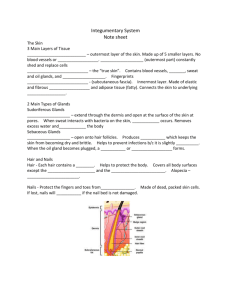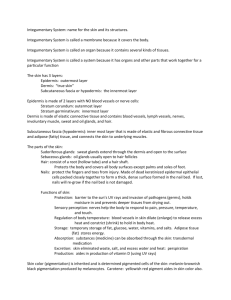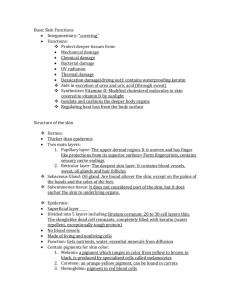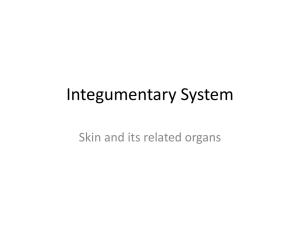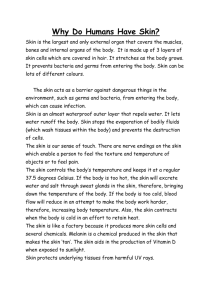chapter 6 outline part II
advertisement
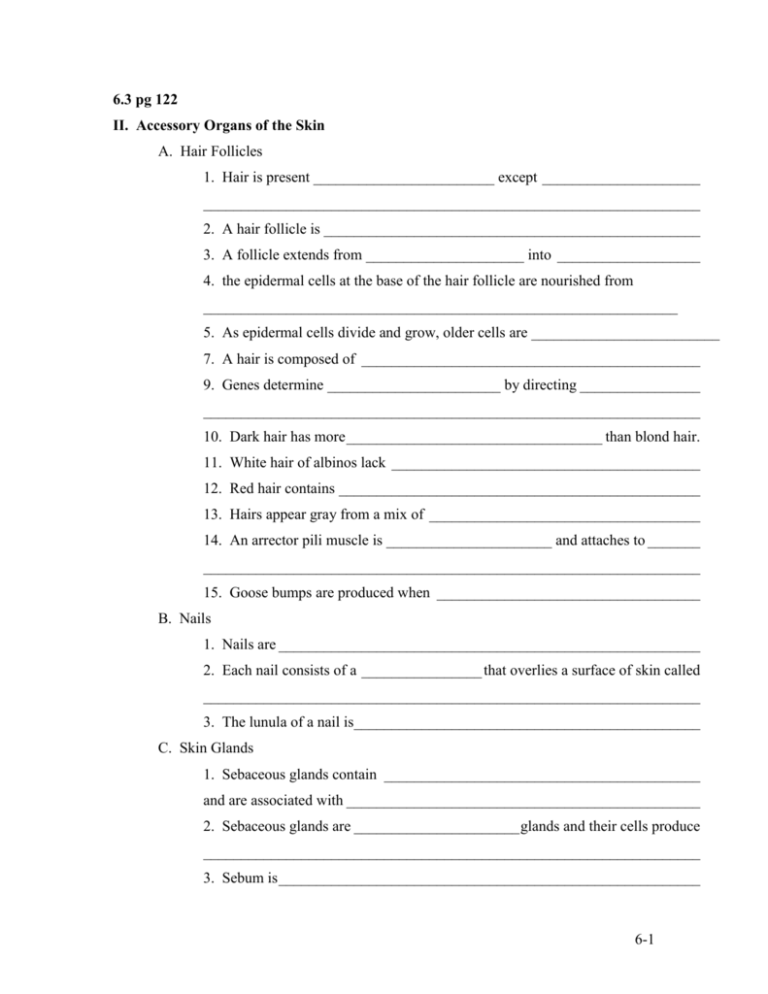
6.3 pg 122 II. Accessory Organs of the Skin A. Hair Follicles 1. Hair is present ________________________ except _____________________ __________________________________________________________________ 2. A hair follicle is __________________________________________________ 3. A follicle extends from _____________________ into ___________________ 4. the epidermal cells at the base of the hair follicle are nourished from _______________________________________________________________ 5. As epidermal cells divide and grow, older cells are _________________________ 7. A hair is composed of _____________________________________________ 9. Genes determine _______________________ by directing ________________ __________________________________________________________________ 10. Dark hair has more __________________________________ than blond hair. 11. White hair of albinos lack _________________________________________ 12. Red hair contains ________________________________________________ 13. Hairs appear gray from a mix of ____________________________________ 14. An arrector pili muscle is ______________________ and attaches to _______ __________________________________________________________________ 15. Goose bumps are produced when ___________________________________ B. Nails 1. Nails are ________________________________________________________ 2. Each nail consists of a ________________ that overlies a surface of skin called __________________________________________________________________ 3. The lunula of a nail is______________________________________________ C. Skin Glands 1. Sebaceous glands contain __________________________________________ and are associated with _______________________________________________ 2. Sebaceous glands are ______________________ glands and their cells produce __________________________________________________________________ 3. Sebum is ________________________________________________________ 6-1 4. Sebum is secreted into _____________________________________________ and helps __________________________________________________________ 7. Sweat glands are also called __________________________________ glands. 8. Each sweat gland consists of ________________________________________ in _______________________________ or ______________________________ 9. The most numerous sweat glands are _________________________________ 10. Eccrine glands respond to _________________________________________ 11. Eccrine glands are common on _____________________________________ 12. A pore is _______________________________________________________ 13. Sweat contains __________________________________________________ 14. Apocrine glands becomes active ____________________________________ 15. They can wet certain areas of skin when a person is _____________________ __________________________________________________________________ 16. Apocrine glands are most numerous in _______________________________ 17. Ceruminous glands of the _____________________ secrete ______________ 18. Mammary glands secrete __________________________________________ III. Regulation of Body Temperature A. Introduction 1. Regulation of body temperature is important because _____________________ __________________________________________________________________ 2. A normal temperature of deeper body parts remains close to _______________ B. Heat Production and Loss 1. Heat is a product of _______________________________________________ 2. When body temperature rises above the set point, nerve impulses stimulate ___ __________________________________________________________________ 3. During physical activity, ________________________________ release heat, which the _______________________________________________ carries away. 4. When warmed blood reaches _______________________________________ , muscles in the walls of __________________________________________ relax. 5. As dermal blood vessels dilate, ______________________________________ escapes to _________________________________________________________ 6-2 6. Skin reddens because ______________________________________________ 7. The primary means of body heat loss is________________________________ 11. Evaporation is __________________________________________________ 12. When sweat evaporates, it carries ___________________________________ 13. When body temperature falls below the set point, muscles of dermal blood vessels _________________________ which decreases _____________________ __________________________________________________________________ 14. When body temperature falls, sweat glands ___________________________ 15. When body temperature continues to fall, small groups of muscles _________ __________________________________________________________________ IV. Skin Color (pg 119) A. Genetic Factors 1. Regardless of racial origin, all people have about the same number of _______ _______________________________________________________ in their skin. 2. Differences in skin color result from __________________________________ __________________________________________________________________ 3. The more ______________________________________ , the darker the skin. 4. The ___________________________ and _____________________________ of pigment granules within melanocytes also influence skin color. B. Environmental Factors 1. Environmental factors such as _______________________________________ and _________________________________________________ affect skin color. 2. These factors stimulate ____________________________________________ C. Physiological Factors 1. When blood is well oxygenated, the blood pigment hemoglobin is __________ ________________________________ and the skin of light-complexioned people appears ___________________________________________________________ 2. When blood oxygen concentration is low, hemoglobin is __________________ ___________________ and the skin appears ______________________________ 3. If dermal blood vessels are dilated, ____________________ blood enters skin 6-3 and skin appears ____________________________________________________ 4. If dermal blood vessels are constricted, _________________ blood enters skin and skin appears ____________________________________________________ 5. Carotene is ______________________________________________________ 6. Carotene can give skin a ______________________________________ color. V. Healing of Wounds and Burns (pg. 125) A. Introduction 1. Inflammation is a normal response to _________________________________ 2. During inflammation, blood vessels __________________________________ and become ________________________________________________________ 3. Inflamed skin may become _________________________________________ and _______________________________________________________________ 4. The dilated blood vessels provide ___________________________________ , which aids _________________________________________________________ 5. The specific events of healing depend on ______________________________ and _______________________________________________________________ B. Cuts 1. If a break in the skin is shallow, epithelial cells _________________________ __________________________________________________________________ 2. If a cut extends into the dermis or subcutaneous layer, ____________________ break and the escaping __________________ forms a ______________________ 3. A clot consists mainly of ___________________________________________ __________________________________________________________________ 4. A scab is ________________________________________________________ 5. Fibroblasts migrate into _____________________________ and begin forming ___________________________ that bind _______________________________ 7. As healing continues, blood vessels___________________________________ 8. __________________________________ remove dead cells and other debris. 9. A scar results when _______________________________________________ 10. A granulation consists of __________________________________________ 6-4 C. Burns 1. A first degree burn is ______________________________________________ 2. A second degree burn is ____________________________________________ 3. ______________________________________ appear in second degree burns. 4. The healing of second degree burns depends on _________________________ __________________________________________________________________ 5. A third degree burn is _____________________________________________ 6. In a third degree burn, the skin becomes _______________________________ 7. If a third degree burn is extensive, treatment may involve _________________ __________________________________________________________________ 8. An autograft is ___________________________________________________ 9. A homograft is ___________________________________________________ 6-5
